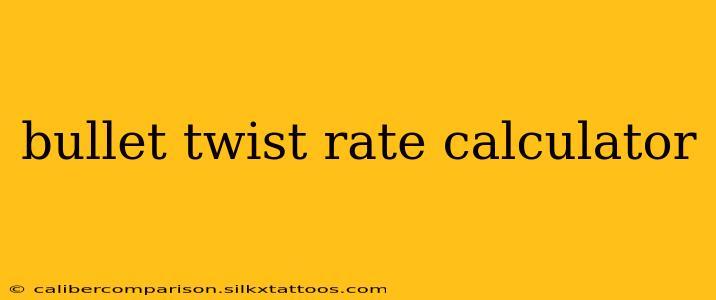Choosing the right twist rate for your rifle barrel is crucial for accuracy and stability. A poorly matched twist rate can lead to poor accuracy, keyholing (the bullet tumbling end-over-end), and even damage to your firearm. This comprehensive guide explains how bullet twist rate calculators work, the factors influencing their calculations, and how to interpret the results to optimize your shooting experience.
Understanding Bullet Twist Rate
The twist rate refers to the rate at which the rifling in your gun barrel rotates the bullet. It's typically expressed as the number of inches required for one complete revolution of the bullet. For example, a 1:10" twist rate means the bullet completes one full rotation every 10 inches of barrel length.
A faster twist rate (e.g., 1:7") means more rapid rotation, while a slower twist rate (e.g., 1:12") means slower rotation. The ideal twist rate depends on several factors, primarily the bullet's length, diameter (caliber), and weight. Longer, heavier bullets generally require a faster twist rate to stabilize in flight.
Factors Affecting Bullet Stability and Twist Rate Calculations
Several key factors influence the stability of a bullet and therefore the ideal twist rate:
1. Bullet Length and Diameter:
Longer and heavier bullets need more spin to maintain stability. A longer bullet presents a larger surface area to the air, requiring a faster twist rate to overcome aerodynamic forces.
2. Bullet Weight:
Heavier bullets require a faster twist rate for stabilization than lighter bullets of the same length and diameter. The added weight increases the moment of inertia, demanding more spin to maintain stability.
3. Bullet Shape:
The bullet's shape (e.g., boat tail, flat base) also plays a role. Boat-tail bullets generally require a slightly slower twist rate compared to flat-base bullets due to their improved aerodynamics.
4. Muzzle Velocity:
Higher muzzle velocities generally require slightly faster twist rates, although the effect is less significant than bullet length and weight. The increased speed magnifies the destabilizing forces acting on the bullet.
How Bullet Twist Rate Calculators Work
Bullet twist rate calculators use mathematical formulas, often based on the Greenhill Formula or more advanced models, to predict the necessary twist rate for a given bullet. These calculators typically require you to input the following information:
- Bullet Diameter (Caliber): The diameter of your bullet, usually expressed in inches or millimeters.
- Bullet Length: The overall length of your bullet, typically measured from the tip to the base.
- Bullet Weight: The weight of your bullet, usually in grains.
- Bullet Shape: Selection of bullet shape (e.g., boat tail, flat base) might be available in more advanced calculators.
- Muzzle Velocity (Optional): Some calculators incorporate muzzle velocity for a more precise calculation.
The calculator then uses the provided data to compute the recommended twist rate. It’s important to note that these calculators provide estimations. Real-world performance may vary slightly due to manufacturing tolerances, powder characteristics, and other factors.
Interpreting Calculator Results
The output of a bullet twist rate calculator usually provides a recommended twist rate, often expressed in inches per revolution (e.g., 1:8"). It's essential to understand that this is a recommendation, not a definitive answer. A slightly faster or slower twist rate might still provide acceptable accuracy. However, a significantly slower twist rate will likely result in instability and poor accuracy.
Choosing a twist rate slightly faster than the calculated recommendation is generally preferred. This provides a margin of safety and ensures sufficient stabilization, especially in adverse conditions.
Conclusion: Optimizing Your Shooting Experience
Using a bullet twist rate calculator is a valuable tool for optimizing your shooting experience. By carefully considering the factors influencing bullet stability and using a reliable calculator, you can improve accuracy and ensure the safe and effective operation of your firearm. Remember, though, that these calculators provide estimates, and practical testing with your specific setup is always recommended for ultimate precision.

